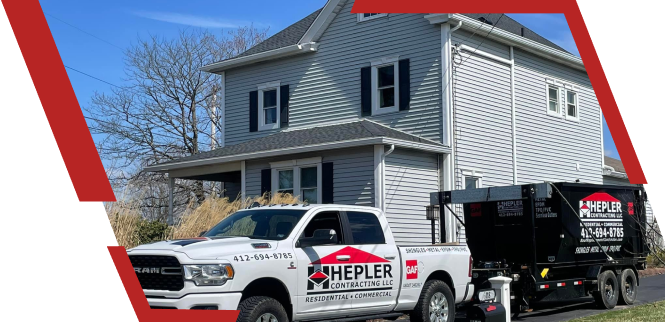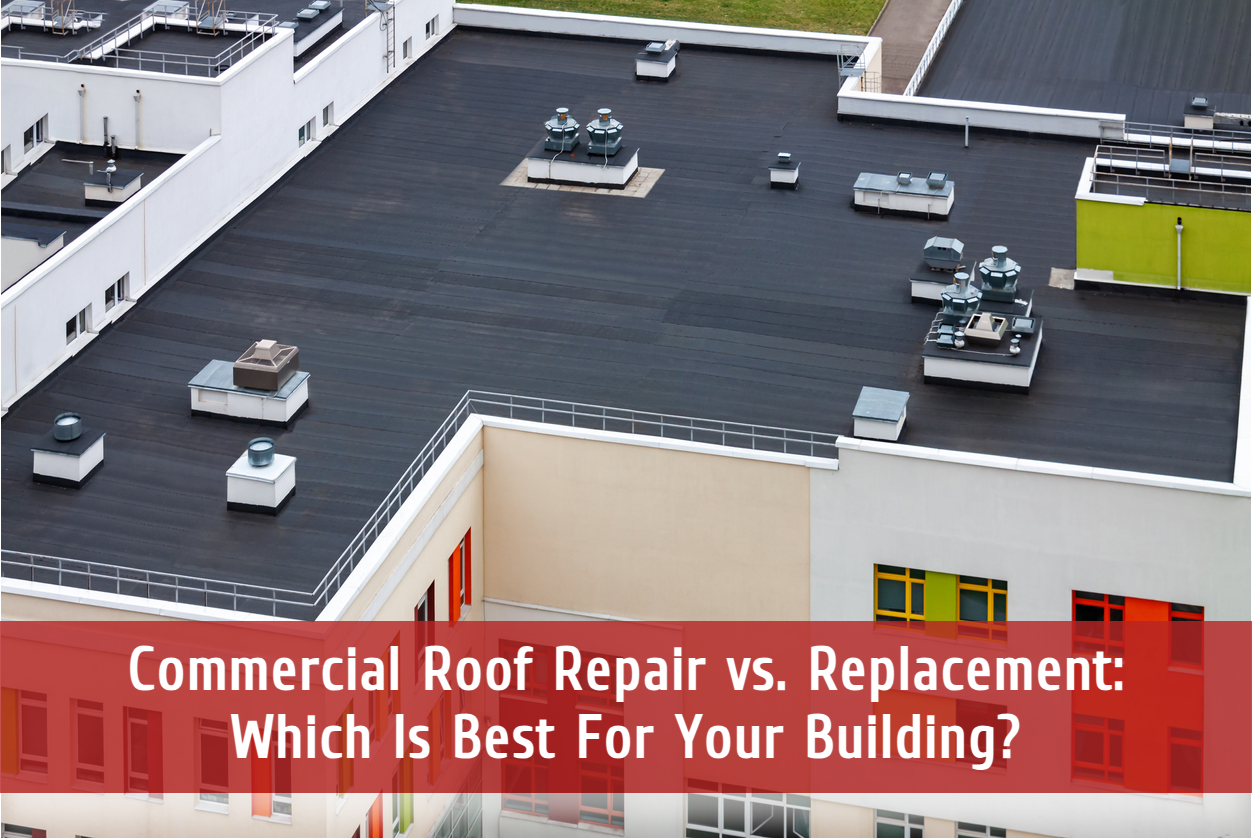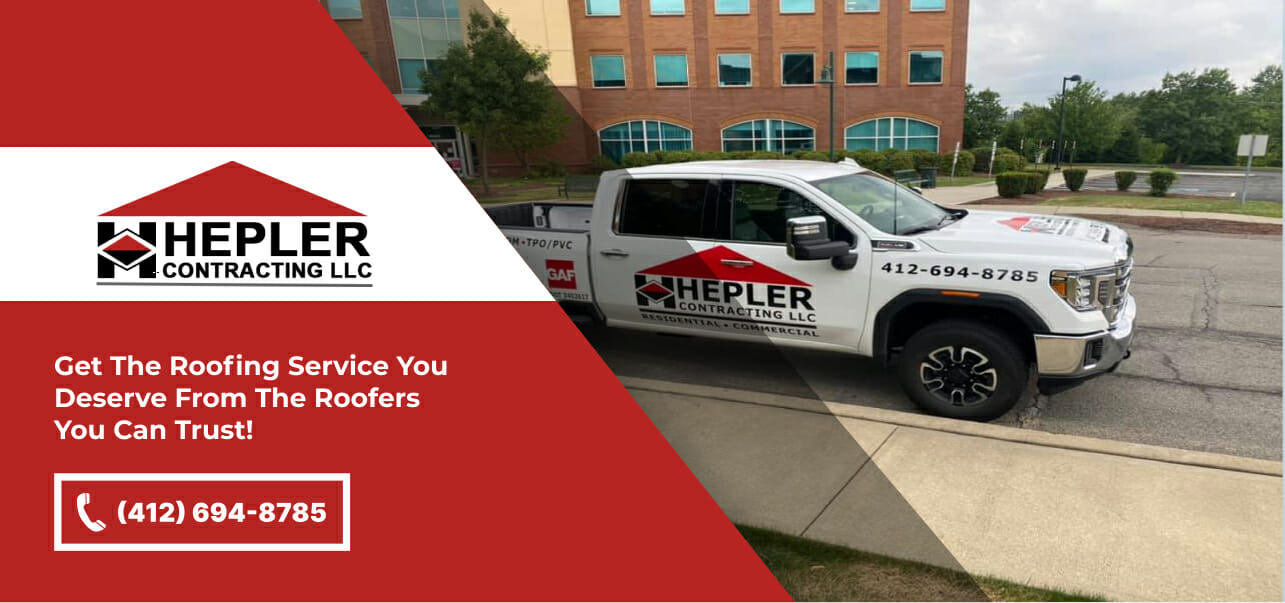Are you a business owner or property manager struggling with the decision of what to do about your commercial roof? You’re not alone. With constant exposure to the elements, commercial roofs can become damaged and therefore need repairs. Understanding the difference between roof repairs, replacement, and routine maintenance will help you make the best decision for your property’s future. In this guide, we will explain all three options, advantages of each, and when to opt for a full replacement over repairs.
Why is Proper Roof Maintenance Important for Commercial Buildings?
Regular roof maintenance is essential for commercial buildings as it helps prevent water damage, maintains energy efficiency, and extends the lifespan of the roof. By conducting regular inspections and repairs, potential issues can be addressed before they become major problems, ultimately saving money in the long run.
Businesses often learn the hard way the importance of roof maintenance. Neglected roofs can result in water leaks during heavy rain, disrupting daily operations and putting products at risk. A regular roof maintenance schedule can work to avoid future issues.
What are the Consequences of Neglecting Roof Maintenance?
Neglecting roof maintenance can have serious consequences, such as leaks, mold growth, and structural deterioration. These issues can lead to increased roof repair costs and decreased energy efficiency. To avoid these problems and ensure the longevity of your commercial roof, it is important to conduct regular inspections and make timely repairs.
Maintaining Your Commercial Roof
These practices can extend the lifespan of the roof, saving on long term costs and minimizing potential disruptions to business operations.
- Regular Inspections: Schedule routine inspections to maintain the health of your commercial roof and promptly address any issues that may arise.
- Clean Gutters and Drains: Ensure proper drainage by regularly cleaning gutters and drains to prevent blockages.
- Repair Leaks: Take immediate action to repair any leaks to prevent water damage and mold growth.
- Trim Overhanging Branches: Protect your roof by trimming any overhanging branches that could potentially cause damage.
- Remove Debris: Keep your roof free of debris by regularly removing leaves and branches to prevent blockages and water buildup.
How Often Should You Schedule Roof Maintenance for Your Commercial Building?
- Regular Inspections: Schedule inspections twice a year to detect early signs of damage or wear.
- Seasonal Checks: Conduct additional checks after extreme weather events like storms or heavy snow.
- Maintenance Plan: Implement a routine maintenance plan to address minor issues promptly.
- Professional Services: Hire professional roofers to conduct comprehensive annual inspections and maintenance.
Different Types of Commercial Roofing Materials
There is a wide range of commercial roofing options, each with their own unique features such as cost, durability, and energy efficiency. These include:
- Metal: Renowned for its long lifespan and low maintenance requirements.
- EPDM: A cost-effective choice with excellent durability.
- TPO: Offers both energy efficiency and resistance to algae and mold.
- PVC: Known for its strength, durability, and chemical resistance.
- Modified Bitumen: Provides flexibility and resilience in extreme temperatures.
- Built Up Roof (BUR): A reliable option that offers durability and weather-resistance.
Signs that Your Commercial Roof Needs to be Repaired or Replaced
- Water Stains: The presence of water stains on the ceiling indicates potential leakage, necessitating roof inspection.
- Bubbling Paint: Bubbling or peeling paint on the ceiling signals trapped moisture due to roof issues, warranting attention.
- Sagging Ceiling: A sagging ceiling points to severe water damage, indicating the need for urgent roof repair or replacement.
- Deteriorating Roof Material: Cracked, torn, or missing roofing materials requires prompt repair to prevent further damage.
What are the Most Common Roofing Problems for Commercial Buildings?
Leaks and water seepage are often a sign of something bigger happening with your roof. Some common roofing problems for commercial buildings include leaks, membrane damage, and ponding water.
It is important to promptly identify and address these problems to prevent further damage. Leaks can be caused by membrane punctures or flashing issues, while ponding water can happen due to clogged gutters, improper installation, or insufficient roof slope.
Professional roofing contractors are trained to identify the issues with commercial roofs that result in interior water damage. Calling a trusted commercial roofer promptly upon discovery of the problem will help diagnose and correct the problem quicker.
How Can You Tell if Your Roof Needs Repairs or a Replacement?
Professional roof inspections will look for a number of things that could be causing water damage in your commercial building. They’ll be able to identify the problem and provide a professional recommendation for corrective action, whether it is to repair or replace the roof. Some of the things they consider during a roof inspection include:
- Interior Leaks: Check for water stains on ceilings or walls, indicating potential roof damage.
- Exterior Inspection: Look for cracked, curled, or missing shingles, as well as moss or algae growth.
- Sagging Areas: Inspect for any sections of the roof that show signs of sagging, indicating structural issues.
- Aging: Consider the age of your roof. If it’s nearing its expected lifespan, replacement may be necessary.
Repairing Your Commercial Roof
If your building’s roof needs repairs, here is a general overview of the steps you should take:
- Assessment: Examine the roof for any indications of damage, such as leaks, cracks, or missing shingles.
- Plan: Formulate a repair plan based on the assessment, taking into account the extent and type of damage.
- Hire Professionals: Enlist the services of qualified commercial roofing contractors to carry out the repairs using industry-standard materials and techniques.
- Quality Control: Ensure that the repaired areas are thoroughly inspected for quality and durability.
- Maintenance: Regularly perform maintenance to prevent minor problems from turning into major damage.
What are Different Types of Roof Repairs?
There are different types of repairs depending on the cause of the damage, including covering punctures, patching leaks, repairing flashing, or addressing structural damage caused by severe weather. It is important to identify the specific issue to determine the most suitable repair method.
For example, a commercial building may have experienced water leakage due to a damaged membrane. In this case, timely patching of the area should be done to prevent further water damage and ensure the structural integrity of the building.
How Much Does Commercial Roof Repair Typically Cost?
There are a variety of factors that contribute to the total cost of commercial roof repairs.
- Inspection: The cost of commercial roof repair typically begins with a professional inspection, which evaluates the extent of damage and necessary repairs.
- Materials: The overall cost is influenced by the type and amount of materials required, including roofing materials, sealants, and protective coatings.
- Labor: The complexity and duration of the repair work determines the labor costs.
- Extent of Damage: The size and severity of the damage can significantly increase the repair cost, especially if it is extensive.
- Additional Features: The cost may vary if additional elements such as skylights, HVAC units, or solar panels require attention during the repair process.
Replacing Your Commercial Roof
Here are some steps to take before starting your commercial roof replacement project:
- Inspection: Assess the current roof’s condition, looking for damage, leaks, or structural issues.
- Plan Your Budget: Determine the costs involved, including materials, labor, and any additional structural modifications.
- Hire a Contractor: Research and hire a reliable roofing contractor experienced in commercial projects.
- Choose Materials: Select durable and energy-efficient roofing materials suitable for your building’s structure and location.
- Permits and Regulations: Obtain necessary permits and ensure compliance with local building codes.
Replacing your commercial roof can improve energy efficiency, enhance property value, and provide long term cost savings. If your building has an outdated roof, these may be additional things to consider when factoring in the costs of a new roof.
When is it Time for a Full Roof Replacement?
A full roof replacement is necessary when the existing roof is extensively damaged, has reached the end of its lifespan, or requires frequent costly repairs. Signs indicating the need for replacement include persistent leaks, sagging areas, and extensive mold growth. If regular maintenance and repairs are no longer effective, it’s time for a full roof replacement.
How Much Does Commercial Roof Replacement Typically Cost?
Similar to commercial roof repairs, the overall cost of a roof replacement depends on a few factors:
- Material Costs: The type of roofing material used, such as EPDM, TPO, PVC, or modified bitumen, significantly affects the overall cost of commercial roof replacement.
- Labor Costs: The cost of professional installation can vary depending on the complexity of the project, type of roofing material, and local labor rates.
- Additional Costs: It is important to consider additional expenses for removing the existing roof, insulation, sheathing, and roof accessories when budgeting for commercial roof replacement.
- Size of the Roof: Generally, larger roofs will have higher replacement costs due to the increased need for materials and labor.
- Roof Access: Limited access to the roof can also impact labor costs and increase the overall cost of commercial roof replacement.
Best Commercial Roof Repair and Replacement Services
If your commercial roof has been damaged or is showing signs of wear and tear, don’t hesitate to call a roofing professional for a roof inspection. At Hepler Contracting, we have years of experience maintaining, repairing, and installing various types of commercial roofs, including EPDM and TPO. For more information about us or our services, give us a call!
Frequently Asked Questions
What factors should I consider when deciding whether to repair or replace my commercial roof?
There are several factors to consider, such as the age and condition of your roof, the extent of damage or wear and tear, and your budget. It’s best to consult with a professional roofing contractor to assess your specific situation and recommend the best course of action.
How do I know if my commercial roof needs to be repaired or replaced?
If your roof is experiencing frequent leaks, has visible signs of damage or wear, or is nearing the end of its expected lifespan, it may be time for repairs or replacement. Regular maintenance can help extend the life of your roof, but if the damage is extensive, it may be more cost-effective to replace it.
Can I repair or replace my commercial roof on my own?
It’s not recommended to attempt repairing or replacing your commercial roof on your own. It’s a complex and dangerous task that requires specialized skills, equipment, and knowledge. It’s best to hire a professional roofing contractor in your area who is experienced in working with commercial roofs.
How long will a commercial roof repair or replacement take?
The timeline for a commercial roof repair or replacement can vary depending on the size and complexity of the project. Typically, minor repairs can be completed within a few hours, while a full roof replacement may take several weeks. Your roofing contractor can provide a more accurate timeline after assessing your specific project.
What is the average lifespan of a commercial roof?
The lifespan of a commercial roof can vary depending on the type of roofing material, climate, and maintenance efforts. On average, a commercial roof can last anywhere from 10 to 50 years. Regular maintenance and prompt repairs can help extend the lifespan of your roof.
Is it more cost-effective to repair or replace my commercial roof?
This depends on the extent of the damage and the overall condition of your roof. In some cases, repairs may be a less expensive solution, especially if the damage is localized. However, if your roof is nearing the end of its lifespan or has widespread damage, it may be more cost-effective in the long run to replace it.


